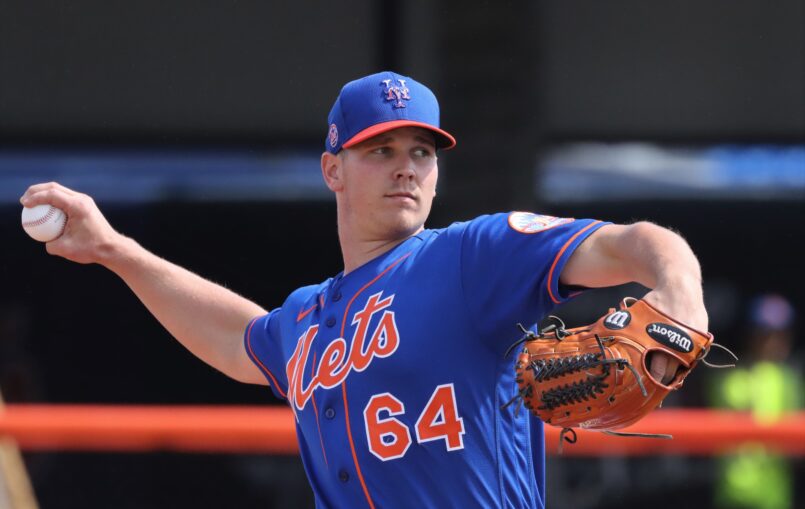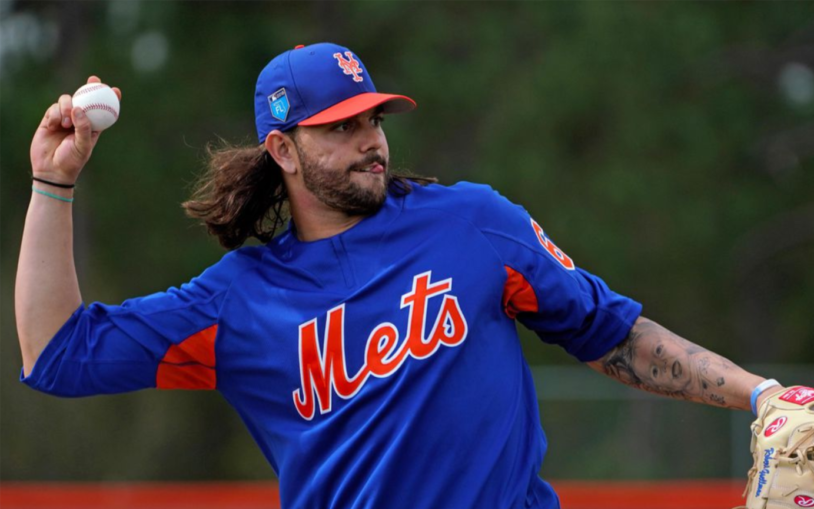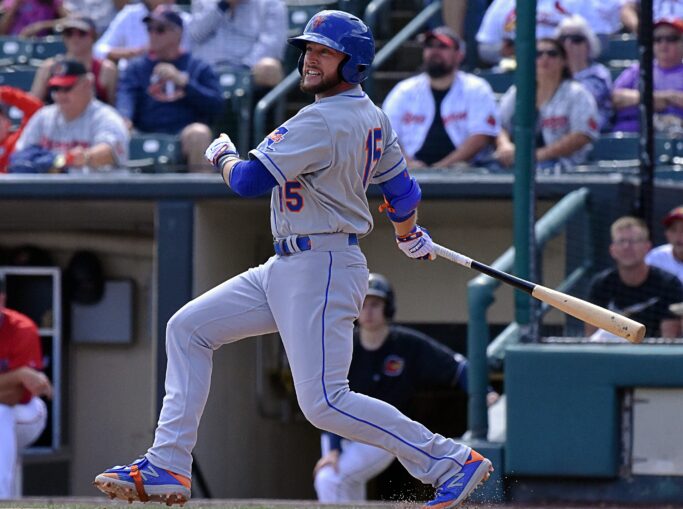
Photo by Ed Delany, MMO
(This is going to get long, so be warned. I’ve added a TL;DR at the bottom.)
Had everything about 2020 been normal, we would not have seen the names of Jordan Humphreys and Franklyn Kilomé appear on the MLB transaction wire except for during spring training when, as a matter of formality, they were optioned to the minor leagues.
Both were/are prospects, but neither was expected to sniff the major leagues unless something catastrophic happened. Even then, the team would have likely brought in a temporary veteran fill-in rather than start the service time clock on guys who they don’t expect to contribute for quite some time.
But this is not a normal season, and the Mets are feeling the consequences of it on their roster.
On Wednesday, the team designated Humphreys for assignment to clear a 40-man roster spot for Ryan Cordell.
On Friday, Kilomé was promoted to the major league roster to replace the injured René Rivera.
In other words: the Mets will have to expose one of their top pitching prospects to the waiver wire and see if another — whose last game was on the last day of the Double-A season in 2018 — can tread water at the back of their bullpen.
Why is this happening? Let’s start at the beginning.
In November, the team decided to protect four prospects from the Rule 5 Draft by adding them to the 40-man roster. Andrés Giménez and Thomas Szapucki were locks as top prospects, but the additions of Humphreys and catcher Ali Sánchez were more questionable as it didn’t seem like either had a significant chance of being picked in the draft, let alone sticking in the majors with another team.
From there, it was clear that those four players, along with Kilomé, who had occupied a spot since being acquired from the Phillies for Asdrubal Cabrera in 2018, would effectively be “shortening” the Mets’ 40-man roster.
That is, forcing the team to really operate with a 35-man roster, since each of those players were highly-regarded prospects that the organization wouldn’t risk losing by removing them but none looked to be significant factors (if one at all) at the major league level in 2020.
Going into spring training in March, the Mets had surprisingly few questions about who would and wouldn’t make the team. The state of the 40-man was never really called into question, since Eduardo Núñez was the only non-roster invite that looked to be in a good position to head north.
Then, everything froze — literally. From March 27 to June 26, no one entered a major league roster and no one came off one as the sport paused to figure out how it would come out of the other side of the most brutal months of the COVID-19 pandemic.
When everything resumed for Summer Camp in late June, the roster outlook for every team had significantly changed. In addition to naming a pool of up to 60 players that were eligible to play in the 60-game season, the active roster limit was increased from 26 to 30.
The one thing that didn’t change? It’s what’s coming around to haunt the Mets now; the limit of 40 players on the 40-man roster has remained the same.
If we take a step back, we realize that larger active rosters are not new. Every September, fans grumble as managers tap into every corner of their 40-man active rosters to pinch-hit, pinch-run, and substitute pitchers ad nauseam. So 30-man rosters… no big deal, right?
But remember when I said that the Mets were essentially limiting themselves to 35 players on the 40? The quick math reveals that would leave just five spots for what I’m referring to as the roster “buffer;” the guys on the 40-man who aren’t on the active roster. That could be players who are optioned to the minors (or in 2020, the Alternate Site) or on the 10-day injured list.
Having as large of a “buffer” as possible is ideal. A team can bring those players up without needing to risk losing someone else to clear a 40-man spot. On a perfectly healthy team, you would have 10 “buffer” players to supplement the active 30.
Health is what’s key here, because as the July 23 deadline to submit Opening Day rosters approached, the Mets began dropping like flies.

Noah Syndergaard‘s placement on the 60-day IL (it’s still called that even though players only need to spend 45 days on it in 2020) opened up a 40-man spot, as did the COVID IL placements of Brad Brach and Jared Hughes.
But Robert Gsellman, Walker Lockett, Jed Lowrie, and Marcus Stroman? Those were all guys who should have been on the Opening Day roster — yes, even Lockett. He was/is out of options — that still counted against the 40.
The pitcher injuries forced the additions of Chasen Shreve and Hunter Strickland onto the roster, and, like Núñez, they needed to be added to the 40. With only two open spots, someone had to go.
That someone was Stephen Gonsalves, still technically a prospect but more importantly a pitcher who has started games at the major league level and was more than adequate depth for the present and future. He was claimed off waivers by the Red Sox days later.
But that only put the Opening Day roster at 29. Needing one more bat, the Mets simply couldn’t afford another DFA to clear room for Max Moroff or Jarrett Parker. So they dipped into the group of five — the prospects who, in a normal year, aren’t factoring into the major league conversation until the very end of the season at the earliest.
To be fair, Giménez has both played much more than I had expected and has done pretty well in his opportunities in the majors so far. But I can’t help but think that his promotion had more to do with not wanting to lose someone else than him actually being big league ready.
Let’s pause and check where we are: 40 players on the 40-man roster, minus our group of now four prospects, gives us 36 players to move around. Subtract the four players who opened on the 10-day injured list and that leaves just two — Tyler Bashlor and Daniel Zamora — as part the entire roster “buffer” (on the 40 but not among the active 30).
I knew two things were bound to happen.
First, the Mets needed a starting pitcher for the fifth game of the season. Once Corey Oswalt, the leading candidate, served in long relief of Rick Porcello in game three he was no longer an option. That meant either a bullpen game (five games into the season? Yeah, no) or the addition of a non-40-man player, since relievers Bashlor and Zamora were the only pitchers in waiting.
Bashlor was actually recalled for Oswalt after his “wear it” performance, but Bashlor was ultimately designated for assignment to clear a 40-man spot for David Peterson, who would have needed to be added in the offseason anyway as a post-2020 Rule 5 eligible player.
But now? The roster “buffer” is down to just Zamora. (And technically Oswalt, but an optioned player can’t be called back up for 10 days unless…)
The second thing I knew to be true, given the Mets’ dastardly injury history, was that someone was bound to go down. I just didn’t expect it to happen so soon.
Despite suffering the injury toward the end of Summer Camp, the team decided to push Jake Marisnick‘s hamstring and keep him on the Opening Day roster, probably because it would have forced them to make another move to replace him. Unsurprisingly, the strain acted up after less than a week.
Zamora (or Oswalt, who was now eligible to be recalled since he would be replacing an injured player) wouldn’t have been any use to replace an outfielder, so the Mets called up Cordell, who needed to be added to the 40.
This is where the roster alarms started blaring. If the team designates Zamora, it’s essentially emptying the “buffer.” So the previously untouchable group of prospects at the end of the 40 had to be disturbed.
Ultimately, the team had to decide which of the four would be most likely to clear waivers. Humphreys, whose only exposure to scouts since the summer of 2017 (when he needed Tommy John surgery) was 11.2 innings in last year’s Arizona Fall League, was the pick.
As of this writing, he’s still in DFA limbo. His fate has to be decided by next Wednesday, Aug. 5, at the latest. Will he clear waivers? Given how desperate some teams are for pitching in this abnormal season, he might not. But it’s hard to see a team spending a 40-man spot (like the Mets did) on as much of a wild card as Humphreys and his injury recovery.
Everyone else is healthy, so the roster should be undisturbed for a while now, right? So, so wrong.
Despite injuring his knee on Sunday, Núñez forced the Mets to play with 29 men until Thursday, when he went on the injured list. Again, with only Oswalt and Zamora in the minors, external reinforcements were needed.
Brian Dozier, who signed at the very end of Summer Camp, was picked as the replacement. He needed a spot on the 40, but this time the Mets crossed positions with their moves, designating Strickland. But that meant they were now down a reliever, so Zamora was finally brought up.
That’s right, the only players left to call up (besides Oswalt, who seems to have run out of chances) without needing to remove someone from the 40 were Kilomé, Sánchez, Szapucki. The three of them have combined for 21 games, all of them Sánchez’s, above Triple-A.
There was certainly a — I don’t want to say “nightmare” — scenario in which one of them would need to be promoted. I’m sure no one in the front office thought it would happen the next day, when Rivera landed on the IL with a hyperextended left elbow.
And that’s how Franklyn Kilomé landed on a major league roster for the first time. *Exhale*

Photo by James Farrance Photography
It isn’t fair to blame all of this — the loss of promising arms and premature promotions — on poor roster management because 10 injured players just can’t be foreseen. But the Mets have backed themselves into a corner that won’t get more spacious anytime soon.
Brach and Hughes are expected back from the COVID IL within a short while. Since they don’t count against the 40-man roster at their current status, two spots will need to be cleared. Sure, it might not be more complex than a DFA of Shreve or Paul Sewald, but they would likely be claimed and that would further harm the already depleted depth.
And even though active rosters were supposed to decrease from 30 to 28 on Aug. 6, the MLB Player’s Association is reportedly pushing for that deadline to be erased. If the change is approved, the solution to the Mets’ roster issues won’t be as simple as optioning Luis Guillorme or Zamora back to the Alternate Site.
The irony in all of this? By admitting that Lowrie — at his best — is going to provide very little to this franchise before the expiration of his two-year contract at the end of this season, the Mets could transfer him to the 60-day IL to clear a spot on the 40 and avoid losing a future contributor.
The two lighthearted mantras I repeat when analyzing roster moves are: “They won’t do it until they absolutely have to” and “If it needed to happen, they would have done it already.”
When it comes to Lowrie, we’re somewhere in the middle.
TL;DR: It isn’t the Mets’ fault that a remarkable ten players have been placed on the injured list. But a lack of expendable players and wiggle room on the 40-man roster have forced undesirable exiles, like prospects Stephen Gonsalves and Jordan Humphreys. How long can they keep backing themselves into this corner? I don’t know, but I’m not sure I want to find out what happens when they do. (Spoiler: it ends with them having to cut someone you like.)















